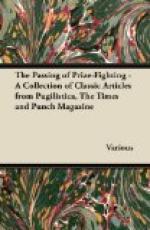It will be seen, by a glance at the above table, that the three great divisions of society, namely, High Life, Low Life, and Middle Life, are subdivided, or more properly, sub-classed, into the Superior, Transition, and Metamorphic classes. Lower still than these in the social scale is the Primitive Formation—which may be described as the basis and support of all the other classes. The individuals comprising it may be distinguished by their ragged surface, and shocking bad hats; they effervesce strongly with gin or Irish whiskey. This class comprehends the St. Giles’s Group—(which is the lowest of all the others, and is found only in the great London basin)—and that portion of the Whitechapel group whose individuals wear Bluchers and ride in pleasure ‘wans’ to Richmond on Sundays. In man’s economy the St. Giles’s Group are exceedingly important, being usually employed in the erection of buildings, where their great durability and hod-bearing qualities are conspicuous. Next in order is the Metamorphic class—so called, because of the singular metamorphoses that once a week takes place amongst its individuals; their common every-day appearance, which approaches nearly to that of the St. Giles’s Group, being changed, on Sundays, to a variegated-coloured surface, with bright buttons and a shining “four-and-nine”—goss. This class includes the upper portion of the Whitechapel Group, and the two lower strata of the Clapham Group. The Whitechapel Group is the most elevated layer of the inferior series. The Shabby Genteel stratum occupies a wide extent on the Surrey side of the water—it is part of the Clapham Group, and is found in large quantities in the neighbourhood of Kennington, Vauxhall, and the Old Kent-road. A large vein of it is also to be met with at Mile-end and Chelsea. It is the lowest of the secondary formation. This stratum is characterised by its fossil remains—a great variety of miscellaneous articles—such as watches, rings, and silk waistcoats and snuff-boxes being found firmly imbedded in what are technically termed avuncular depositories. The deposition of these matters has been referred by the curious to various causes; the most general supposition being, a peremptory demand for rent, or the like, on some particular occasion, when they were carried either by the owner, his wife, or daughter, from their original to their present position, and left amongst an accumulation of “popped” articles from various districts. The chief evidence on this point is not derived from the fossils themselves, but from their duplicates, which afford the most satisfactory proof of the period at which they were deposited. Articles which appear originally to have belonged to the neighbourhood of Belgrave-square have been frequently found in the depositories of the district between Bethnal-green and Spitalfields. By what social deluge they could




